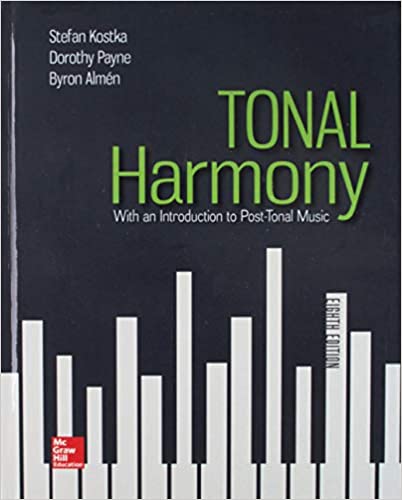Tonal Harmony 8th Edition by Stefan Kostka, ISBN-13: 978-1260185300
[PDF eBook eTextbook] – Due to its large file size (147 MB), this book may take longer to download.
- Access code NOT included
- Publisher: McGraw-Hill Education; 8th edition (February 28, 2017)
- Language: English
- 704 pages
- ISBN-10: 1260185303
- ISBN-13: 978-1260185300
Tonal Harmony with an Introduction to Post-Tonal Music is intended for a two-year course in music theory/harmony. It offers a clear and thorough introduction to the resources and practice of Western music from the seventeenth century to the present day. Its concise, one-volume format and flexible approach make the book usable in a broad range of theory curricula.
The text provides students with a comprehensive but accessible and highly practical set of tools for the understanding of music. Actual musical practice is emphasized more than rules or prohibitions. Principles are explained and illustrated, and exceptions are noted. In its presentation of harmonic procedures, the text introduces students to the most common vocal and instrumental textures encountered in tonal music. Traditional fourpart chorale settings are used to introduce many concepts, but three-part instrumental and vocal textures are also presented in illustrations and drill work, along with a variety of keyboard styles. To encourage the correlation of writing and performing skills, we have included musical examples in score and reduced-score formats, as well as appendices on instrumental ranges and transpositions and lead-sheet symbols. Some of the assignments ask the student to write for small ensembles suitable for performance in class. Instructors may
The text employs a variety of techniques to clarify underlying voice leading, harmonic structure, counterpoint, and formal procedures. These include textural reductions, accompanying many of the examples, which highlight underlying voice leading. Our goal has been to elucidate tonal logic at the phrase and section level, as well as from one chord to the next. Abundant musical illustrations, many with commentaries, serve as a springboard for class discussion and individual understanding. Similarly, exercises in tonal counterpoint allow students to observe the workings of basic principles of melodic combination in relation to typical outer-voice textures in tonal compositions. The book provides an extensive series of review material. A large portion of the text is devoted to Self-Tests, consisting of student-graded drills in chord spelling, part writing, and analysis, with suggested answers given in Appendix D. The Self-Tests can be used for in-class drill and discussion, in preparation for the Workbook exercises, or for independent study. Periodic Checkpoints enable students to gauge their understanding of the preceding material. Chapter summaries highlight the key points of each chapter. A glossary of the bolded terms found throughout the text is also included.
Part One (Chapters 1–4) begins the text with two chapters that provide a thorough but concise overview of the fundamentals of music, divided into one chapter each on pitch and rhythm. These chapters may be assigned in reverse order, if desired, except for the review questions in Chapter 2. Chapters 3 and 4 introduce the student to triads and seventh chords in various inversions and textures and places them in their tonal contexts.
Part Two (Chapters 5–13) opens with two chapters on the principles of voice leading, with practice limited to root position triads. Chapter 7 follows with a systematic discussion of normative harmonic progressions. Subsequent chapters deal with triads in inversion (Chapters 8 and 9), basic elements of musical form (Chapter 10), counterpoint (Chapters 11 and 12), and nonchord tones (Chapters 12 and 13).
Part Three (Chapters 14–15) is devoted entirely to diatonic seventh chords, moving from the dominant seventh in root position and inversion (Chapter 14) through the supertonic and leading-tone sevenths to the remaining diatonic seventh chords (Chapter 15).
Part Four begins the study of chromaticism with secondary functions (Chapters 16–17) and modulation (Chapters 18–19), concluding in Chapter 20 with a discussion of larger musical forms.
Chromaticism continues to be the main topic in Part Five (Chapters 21–25), which covers mode mixture, the Neapolitan, augmented sixth chords, enharmonicism, and other elements. The final chapter of this section concentrates upon harmony in the late nineteenth century.
Part Six (Chapters 26–28) provides a substantial introduction to post-tonal music, beginning, in Chapter 26, with a survey of scales, chord structures, voice leading, and aspects of rhythm. Chapter 27 discusses the basics of atonal theory, including pitch-class sets, twelve-tone serialism, and total serialism. Appendix C, a list of set-classes, is a useful supplement to this chapter. More recent developments, such as indeterminacy, minimalism, and electronic and computer music, are discussed in the final chapter.
New to This Edition
The most changed chapters are Chapters 11, 12, and 15. Chapter 11, “Two-Part Tonal Counterpoint,” is entirely new and, as the title suggests, is devoted to a brief introduction to tonal counterpoint. As such, it covers roughly the same basic terrain as first-species, or one-to-one, counterpoint but also integrates this material with norms of tonal harmony (major and minor scales, modern meters, tonal cadences, and triadic harmony). The emphasis is on writing lines that conform to good tonal progressions, while keeping in mind the principles of species counterpoint. The resulting compositional examples most resemble basic soprano-bass (or outer-voice) combinations. Chapter 12, “Nonchord Tones 1,” contains material that appeared in the seventh edition as Chapter 11, but it also includes further discussion of counterpoint—in this case, a second-species-equivalent tonal counterpoint that adds passing tones and arpeggiations to the one-to-one texture. The two subsequent chapters, Chapters 13 (“Nonchord Tones 2”) and 14 (“The V7 Chord”), have been renumbered from the seventh edition, where they appeared as Chapters 12 and 13, respectively. Chapter 15, “Other Diatonic Seventh Chords,” is a condensation and synthesis of two chapters (Chapters 14 and 15) from the seventh edition. As such, it contains coverage of all diatonic seventh chords except the V7 chords discussed in the previous chapter. The four optional counterpoint units that were coordinated with the seventh edition, and that appeared on the McGraw-Hill website, have been replaced by the new material in Chapters 11 and 12. Students or instructors desiring a greater degree of faithfulness to species principles can still access and download these counterpoint materials from the McGraw-Hill Education Connect.
What makes us different?
• Instant Download
• Always Competitive Pricing
• 100% Privacy
• FREE Sample Available
• 24-7 LIVE Customer Support






Reviews
There are no reviews yet.